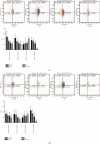LAG3 and PD1 Regulate CD8+ T Cell in Diffuse Large B-cell Lymphoma Patients
- PMID: 34422089
- PMCID: PMC8378962
- DOI: 10.1155/2021/4468140
LAG3 and PD1 Regulate CD8+ T Cell in Diffuse Large B-cell Lymphoma Patients
Retraction in
-
Retracted: LAG3 and PD1 Regulate CD8+ T Cell in Diffuse Large B-cell Lymphoma Patients.Comput Math Methods Med. 2023 Sep 27;2023:9831240. doi: 10.1155/2023/9831240. eCollection 2023. Comput Math Methods Med. 2023. PMID: 37811301 Free PMC article.
Abstract
Background: Diffuse large B-cell lymphoma (DLBCL) is a clinically and genetically heterogeneous lymphoid malignancy. The unsatisfactory outcome for refractory patients has prompted efforts to explore new therapeutic approaches for DLBCL. However, the mechanisms involved in treatment associated with immune checkpoints remain unclear. This study is aimed at investigating the potential roles of programmed cell death protein 1 (PD1) and lymphocyte activation gene 3 (LAG3) in CD8+ T cells for treatment in DLBCL.
Methods: Utilizing flow cytometry, we examined the content of T cells, the levels of cytokines, and the expression of PD1 and LAG3 in patients with DLBCL as well as in healthy controls. Levels of cytokines in CD8+ T cells from DLBCL patients before and after treatment were compared by blocking of PD1 and LAG3 in magnetic bead-sorted CD8+ T cells.
Results: We found that the proportion of CD4+ T cells and CD8+ T cells was increased in DLBCL patients after treatment. The levels of cytokines trended toward those of healthy controls in treatment. PD1 (+), LAG3 (+), or PD1 (+) LAG3 (+) were all expressed in lower amounts in CD4+ T cells and CD8+ T cells after treatment than in untreated DLBCL patients. In addition, blockade of PD1 and LAG3 in sorted CD8+ T cells markedly inhibited cytokine production in response to treatment.
Conclusion: PD1 and LAG3 in CD8+ T cells may be important targets of therapy and play therapeutic role in patients with DLBCL.
Copyright © 2021 Ying Liu et al.
Conflict of interest statement
All authors declare no competing interests.
Figures




References
Publication types
MeSH terms
Substances
LinkOut - more resources
Full Text Sources
Research Materials

